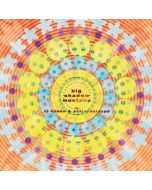JACQUES VAN ERVEN
| Artist | JACQUES VAN ERVEN |
|---|---|
| Titel | Tunes & Scenery (Hard To Whistle) |
| Format | LP |
| Label | Futura Resistenza |
| Country | Belgium |
| Cat.-No. | RESLP001 |
The record you have in your hands was once a cassette from the vast Dutch home-taping culture of the eighties. Tunes & Scenery (Hard To Whistle) is an adventurous and quite unique work that was originally recorded on an analog four-track in 1983 by the young visual artist and musician Jacques van Erven. The album brings together the surprising combination of analog synthesizers, small Casio keyboards, a mouth harp, ukulele, marimba, and a variety of drums. A kind of hybrid music of contemporary jazz and world music combined with influences of rock and new wave in opposition spread over fifteen instant composed songs. The album was recorded in the small village of Aalst (not far from the southern Dutch city of Eindhoven) with the help of engineer Koos Behrtel at the studio where Jacques van Erven was painting and playing music. We have included an image of a painting by Jacques with this release. It’s one of his stunning paintings from that time and is interconnected with the music of Tunes & Scenery (Hard To Whistle) and his artistic practices and visions. A little story:
The city of Eindhoven and its surroundings has always had an interesting and progressive music scene. It was the birthplace of the Dutch consumer electronics company Philips that was involved with the first electronic music in The Netherlands during the fifties. At the Philips experimental electronics studio NatLab, composers like Dick Raaijmakers and Tom Dissevelt created their first electronic sounds based on oscillating tone generators and tape cut-up and manipulation. Philips would go on to invent and manufacture the Compact Cassette in 1963 that, years later, would become the medium for homemade and self-produced music output worldwide. Philips would soon also function as an important international record label, and was one of the first companies to combine its media with its own content. The story of Philips and Eindhoven exemplifies how technology and art were always intertwined in the city.
Gradually, during the early eighties, a cultural and artistic infrastructure came into existence in Eindhoven and it presented new possibilities for creative experimentation and musical freedom. Aside from the important museum for modern art Van Abbemuseum that had been a hub for avant-garde since 1936, smaller art galleries and initiatives opened their doors. These included Het Apollohuis, the social center and art squat 2B, and the art space De Fabriek (not to be mistaken for the home-taping group from The Netherlands). Within this context, quite an elaborate post-punk and new wave scene developed in Eindhoven. The city’s most important concert hall, De Effenaar, had an extensive new wave program and bands such as Joy Division played there. Alongside a small boom of little alternative galleries, many local bands had risen up – most notably the post-punk band Nasmak, but other groups, too, such as Plus Instruments and the industrial artist commune of De 6de Kolonne, known for bands like Vovo Kai and Zwoek.
Jacques van Erven too was a young Dutch artist and multi-instrumentalist from Eindhoven. And while he had graduated from the art academy in Tilburg and later went on to do the Jan van Eyck Academie in Maastricht, Eindhoven remained the central place for his musical practices. Influenced by various elements of the musical spectrum – from The Beatles, Varèse, and Soft Machine to Don Cherry, Rip, Rig + Panic, and the then-contemporary post-punk scene – van Erven began experimenting with his own music that was hard to classify. He started out in the new wave band A Live Detail, a band that never released anything but played as local support for internationally renowned acts like Lydia Lunch and Echo & The Bunnymen. During the early eighties van Erven travelled away from classic new wave sounds and created two solo albums that came out on the great impro-jazz and new wave fusion label Eksakt from Tilburg. Tunes & Scenery (Hard To Whistle) is his earliest work to show a great combination of different moods and styles. It has influences from Victorian poetry (the title of the track ‘It’s Not Always May’ is taken from a poem by Henry Wadsworth Longfellow) as well as world music, jazz, and new wave. After this flurry of production, Jacques van Erven released only one other track for a Christmas tape compilation in 1985 curated by Oscar Smit, who was also a leading force behind Dutch underground music magazine Vinyl.
Tunes & Scenery (Hard To Whistle) remains to this day one of those Dutch recordings from the eighties that pretty much stands on its own. Although there existed some acts in the same vein during that time in the Netherlands like Niew Hip Stilen, The Schismatics or Random Bob, the music remains unique, especially considering it’s a solo effort. At times when the new wave and post-punk sounds were prevailing, the decision to opt for a hybrid form of jazz and world music mediated through unorthodox instruments combined with analog electronic gear was a nice escape from the fashionable box. Jacques van Erven recalls it to have been a memorable time when he was immersed in his artistic practice. His music was interwoven with his daily creative practice. The studio was full of canvases and strange instruments, emanating the smell of paint, with Jacques at the centre of all this, experimenting and creating. A universe of its own that was captured on a four-track in 1984.
This album will surely appeal to fans of other bands like Ptôse, Niew Hip Stilen, Achwghâ Ney Wodei, Look de Bouk or Woo.
Text written by Bence Meijer – Archaic Inventions
(label info)







